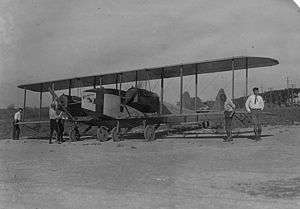Barnhart Twin 15
| Twin 15 "Wampus-Kat" | |
|---|---|
 | |
| Role | Biplane |
| National origin | United States of America |
| Manufacturer | C.R. Little Aircraft Works |
| Designer | G. Edward Barnhart |
| Introduction | 1920 |
| Number built | 1 |
The Barnhart Twin 15 "Wampus-Kat" is a twin engine biplane that was built in 1920.
Design and development
The prototype was built in Pasadena, California in 1920 by G.E. Barnhart, an engineer for the Handley Page program.[1]
The "Wampus-Kat" was a twin engine conventional landing gear-equipped biplane with folding wings. There are ailerons on both upper and lower wings. The wooden fuselage had a small nose-mounted door that allowed access for four passengers inside and one pilot in an open cockpit above. All surfaces are fabric covered except the cabin. The main fuel tank was below the fuselage with a small gravity feeder tank.[2]
Operational history
The Wampus-Kat was christened with a spray of roses in Pasadena in August 1921. Four passengers flew in a flight demonstration.[3] It was wrecked in a windstorm at the (Altadena golf course) Makepeace Airport in California. Financing for a rebuild was not obtained, and further development stopped.[4]
Specifications (Barnhart Twin "Wampus-Kat")
Data from Flight[2]
General characteristics
- Capacity: 5
- Length: 30 ft 10 in (9.40 m)
- Wingspan: 50 ft (15 m)
- Height: 11 ft (3.4 m)
- Wing area: 484.9 sq ft (45.05 m2)
- Airfoil: R.A.F. 6A
- Gross weight: 4,015 lb (1,821 kg)
Performance
- Cruise speed: 78 kn; 145 km/h (90 mph)
- Stall speed: 35 kn; 64 km/h (40 mph)
- Service ceiling: 11,600 ft (3,500 m)
- Rate of climb: 350 ft/min (1.8 m/s)
- Wing loading: 8.23 lb/sq ft (40.2 kg/m2)
- Power/mass: 22.3lb/hp
See also
- Aircraft of comparable role, configuration and era